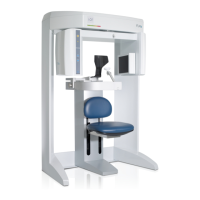
Do you have a question about the i-CAT FLX V Series and is the answer not in the manual?
| Scan Type | Cone Beam Computed Tomography (CBCT) |
|---|---|
| Applications | Orthodontics, TMJ Analysis, Airway Analysis |
| Voxel Size | As low as 0.2 mm |
| Scan Time | 4.8 seconds to 26.9 seconds (full scan) |
| Detector Type | Amorphous silicon flat panel sensor |
| X-ray Generator | High-frequency generator |
| Patient Positioning | Seated or standing |
| Software | Tx STUDIO |
| Power Requirements | 110-240 VAC, 50/60 Hz |
| Dimensions | Varies by model |
| Weight | Varies by model |
| Imaging Technology | Cone Beam CT |
Describes the location and function of the patient emergency stop button.
Procedure for powering on the i-CAT FLX scanner and its controller.
Detailed steps to power up the scanner and the scanner controller.
Guides on scheduling new and existing patients using SmartScan STUDIO Manager.
Emphasizes patient health and responsible selection of scan protocols and dose settings.
Guidelines for selecting optimal scan protocols based on patient and case requirements.
Quick guide for positioning patients for CT scans to ensure minimal movement and optimal image quality.
Quick guide for positioning patients for Panoramic scans.
Detailed explanation of patient positioning features and their correct usage.
Guidance on using the head support and strap for patient head stabilization.
Explanation of how to use the laser alignment lights for precise patient positioning.
Steps for acquiring the actual CT or PAN scan for diagnostic purposes.
Step-by-step guide to perform the weekly panel calibration procedure.
Importance and procedure for performing weekly shutter calibration to ensure image quality.
Step-by-step guide to perform the shutter calibration procedure.
General principles and regulations concerning radiation safety with the scanner.
Specific measures to protect patients and operators from radiation exposure.
Essential warnings and precautions for safe operation and to prevent injury or harm.
Description of built-in safety features such as warning systems and interlocks.
Information on the location and use of emergency stop buttons for immediate power cut-off.
Procedure for safely removing a patient from the scanner during an emergency.
Steps to take if a scanner stall or collision is detected during operation.